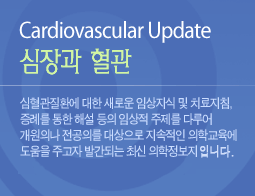이달의 kcj Hot Article / 2025년 8월
Effect of Operator Experience Performing Rotational Atherectomy on Clinical Outcomes After Percutaneous Coronary Intervention |
| 저자 |
Woochan Kwon, MD,1
Ki Hong Choi, MD, PhD,2
Young Bin Song, MD, PhD,2
Joo Myung Lee, MD, MPH, PhD,2
Taek Kyu Park, MD, PhD,2
Jeong Hoon Yang, MD, PhD,2
Joo-Yong Hahn, MD, PhD,2
Seung-Hyuk Choi, MD, PhD,2
Jae-Hwan Lee, MD, PhD,3
Min Chul Kim, MD, PhD,4
Hyun-Jong Lee, MD, PhD,5
and Hyeon-Cheol Gwon, MD, PhD2 |
| 소속 |
1 Division of Cardiology, Department of Internal Medicine, Kangbuk Samsung Hospital, Sungkyunkwan University School of Medicine, Seoul, Korea.
2 Division of Cardiology, Department of Internal Medicine, Heart Vascular Stroke Institute, Samsung Medical Center, Sungkyunkwan University School of Medicine, Seoul, Korea.
3 Division of Cardiology, Department of Internal Medicine, Chungnam National University Sejong Hospital, Chungnam National University School of Medicine, Sejong, Korea.
4 Division of Cardiology, Department of Internal Medicine, Chonnam National University Hospital, Chonnam National University Medical School, Gwangju, Korea.
5 Division of Cardiology, Department of Medicine, Sejong General Hospital, Bucheon, Korea. |
Background and ObjectivesRotational atherectomy (RA) is a technique used to ablate calcified plaques. There is speculation that operators’ experience with RA could play a role in the outcomes. MethodsFrom December 2015 to April 2020, patients with calcified coronary lesions requiring percutaneous coronary intervention (PCI) with RA were enrolled in a prospective, multicenter, observational registry. The patients were divided into two groups based on the number of RAs performed by their operator in the past. A propensity score matching was done for a sensitivity analysis. The primary outcome was a composite of cardiac death, myocardial infarction, and target vessel revascularization at 1 year. ResultsA total of 497 patients were enrolled in the study. The calculated cutoff number of RA-PCI between the two groups was 82 cases. The more experienced group underwent PCI with less fluoroscopy time (less experienced vs. more experienced, 38.8 vs. 30.0 minutes, p<0.001), and more frequent intravascular imaging (54.6% vs. 69.0%, p=0.012). The primary outcome did not differ significantly between the groups (5.2% vs. 7.3%, hazard ratio, 1.46; 95% confidence interval [CI], 0.57–3.74; p=0.433). No significant difference in the incidence of complications was observed between the groups (5.5% vs. 7.0%, odds ratio, 1.38; 95% CI, 0.57–3.04; p=0.526). Similar results were observed in the propensity-score matched population. ConclusionsIn PCI using RA for calcified lesions, the composite outcome of cardiac death, myocardial infarction, and target vessel revascularization at 1 year was not significantly different according to RA experience among operators.
|
| 첨부파일1 |
 KCJ-24-318 GA.jpg (다운 59회) KCJ-24-318 GA.jpg (다운 59회) |









